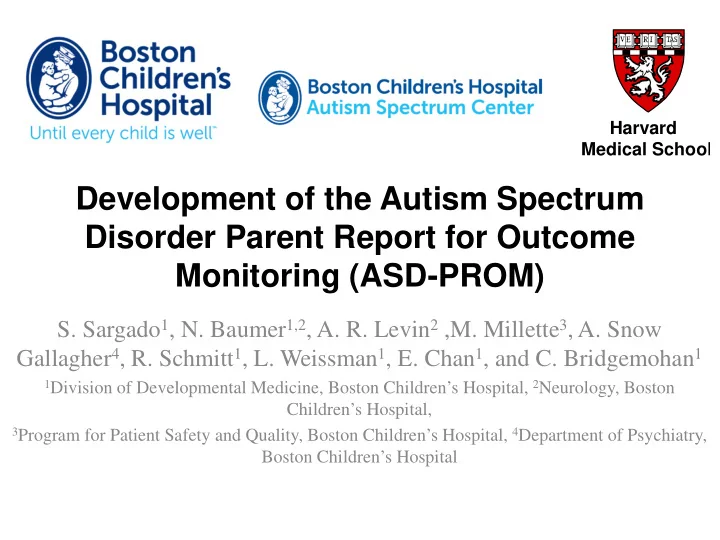

Harvard Medical Schoo l Development of the Autism Spectrum Disorder Parent Report for Outcome Monitoring (ASD-PROM) S. Sargado 1 , N. Baumer 1,2 , A. R. Levin 2 ,M. Millette 3 , A. Snow Gallagher 4 , R. Schmitt 1 , L. Weissman 1 , E. Chan 1 , and C. Bridgemohan 1 1 Division of Developmental Medicine, Boston Children’s Hospital, 2 Neurology, Boston Children’s Hospital, 3 Program for Patient Safety and Quality, Boston Children’s Hospital, 4 Department of Psychiatry, Boston Children’s Hospital
Introduction Children with Autism Spectrum Disorder (ASD) face multiple challenges & comorbidities Monitoring developmental progress and behavioral functioning is critical to Assess effectiveness of services Improve quality of care for children with ASD No currently available tool to assess progress and measure outcomes across all domains of functioning Goal: develop an ASD-specific parent report measure focused on family centered outcomes capture skills across the full range of developmental function address developmental outcomes and behavioral concerns measure change over time ultimately available in an electronic format
Methods: ASD-PROM Development 1. Create draft with inputs from a multidisciplinary group of experts 127 Likert type questions Assess key domains of clinically relevant developmental and behavioral functioning Assess change over time 2. Pilot the ASD-PROM using cognitive interview to assess clarity and relevance to families
Results: Iterative Process for Updating ASD- PROM Based on Pilot Feedback Feedback from Updated Version Cognitive Interview of ASD-PROM
Discussion Participants provided positive feedback for ASD-PROM “This helps me see where we were before and how far we’ve come.” – Participant 2 “This addressed every part of what you would see in autism, across the spectrum.” – Participant 6 Potential strengths of ASD-PROM Monitoring outcomes for children with ASD Sensitivity to change over time Applicability to children with ASD at variable levels of functioning Utility in clinical and research settings Free availability for use by clinicians and researchers
Conclusion and Next Steps 1. Administer the ASD-PROM electronically via a web-based information sharing system Integrated Clinical Information Sharing System (ICISS) Features: • Automated emails and online links to questionnaires HIPAA-compliant data storage, behind a hospital firewall • Clinicians receive notification emails • • Graphing shows change over time • Results are in a natural language which can be used as narrative for clinical notes
Conclusion and Next Steps 2. Pilot in the electronic system with additional parent and clinician surveys to assess ease of use and clinical relevance 3. Evaluate test re-test reliability 4. Compare performance to standardized assessment tools 5. Examine ability to measure change over time 6. Use item response theory to identify the most relevant subset of questions
Recommend
More recommend